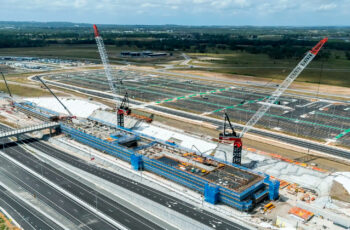Logistics on the Edge: How Borrowing Keeps Firms from Collapse
Pre-default Risks in Logistics: How Loans Help to Survive
Most people picture logistics as ships queuing at ports or trucks pacing the highway. Fewer see the fragile cash cycles underneath. Every container move rests on invoices, fuel bills, leases, and payroll that must line up just right. When they don’t, a company can drift into the grey zone before failure—paying its dues for now, but burning through cash and goodwill. That is pre-default risk: not collapse, but the slide toward it. In a sector built on thin margins and tight schedules, loans can be the shock absorber that keeps wheels turning long enough to fix the underlying problems.
What pre-default really looks like
Pre-default rarely arrives with drama. It shows up as “one more week” on a supplier payment, a stretched overdraft, a client who pays later each cycle. The balance sheet still stands, but liquidity is fraying. Logistics firms feel this first because costs are fixed and relentless—fuel, drivers, insurance, depot fees, vessel or trailer leases. You can’t park a fleet for a month and wait; contracts and routes demand continuity. A strike at a port, a spike in diesel prices, sanctions rerouting freight, or a sudden currency swing can tip a stable operator into cash stress, even if the business remains fundamentally sound.
Why logistics is uniquely exposed
Logistics is both global and hyperlocal. A forwarder in Hamburg might await payment from Asia while funding last-mile transport in the same week. Delays in one geography ripple through the entire chain. Because lenders know disruption anywhere can hit borrowers everywhere, credit to the sector often includes tight monitoring and covenants. That scrutiny can feel tough in good times, but it becomes an asset in bad ones: facilities are designed with drawdown flexibility, maturity headroom, and renegotiation triggers that can be activated before a missed payment turns into a default.
Loans as a bridge, not a crutch
When the warning lights flash, many logistics firms don’t need permanent rescue—they need time. Short-term working-capital loans, revolving credit, and supplier finance buy that time. A shipping operator squeezed by bunker costs might draw on a seasonal facility to cover fuel until new contracts price in the increase. A road carrier under diesel pressure may use a floating-rate line tied to a fuel index, smoothing repayments across volatile months. These instruments are less about leverage and more about calendar: aligning cash outflows with cash inflows so operations continue while pricing and routes adjust.
Restructuring before the cliff
Sometimes the problem is deeper than a bad quarter. Expansion debt from a growth cycle can become a burden when rates rise or volumes slip. In that case, pre-default survival usually means restructuring. Banks increasingly prefer extending tenors, consolidating multiple loans, or granting short grace periods over forcing a formal default that destroys value. The logic is simple: ships, trailers, warehouses, and contracts retain value if the borrower stays alive. Container shipping’s last downturn proved it—carriers that secured maturity extensions and covenant resets rode the recovery; those that didn’t vanished or sold assets at distress prices.

Keeping trust when money is tight
Cash stress is also a social risk. Drivers talk, depots gossip, customers sense hesitation. Reputation deteriorates faster than cash flows. Securing a bridge loan or a formal reschedule counteracts that spiral: salaries land on time, fuel cards keep working, vendors are paid within negotiated windows. That visible stability buys management the credibility to renegotiate rates, re-route loads, or unwind loss-making contracts. In logistics, trust is capital; loans protect it while the turnaround plan takes hold.
Data, transparency, and earlier help
Credit has become more real-time. Lenders ask for operational indicators—turn times, filled miles, demurrage, days sales outstanding—alongside financials. For borrowers, sharing data feels exposing; in practice, it speeds support. If a bank can see volumes, delays, and fuel intensity daily, it can approve incremental liquidity before arrears show up. The trade-off is structure: early help often comes with reporting covenants and triggers for cost actions. But that discipline is exactly what keeps pre-default from becoming default.
When shocks turn systemic
We saw the playbook during the pandemic: border closures and demand shocks pushed airlines, forwarders, and truckers to the edge. Emergency loans—public and private—kept assets active and people employed until trade restarted. Smaller shocks follow the same pattern at local scale: a port strike, a sudden customs rule, a currency devaluation. Each can create a liquidity gap big enough to break a good company. Tailored financing fills that gap, preventing cascading failures through suppliers, drivers, and clients who rely on those links.
How to borrow without mortgaging tomorrow
Credit that saves today must not sink tomorrow. The firms that emerge stronger treat borrowed time as an operating window, not a vacation. They move fast on three fronts. First, pricing: index fuel surcharges properly, rebid lanes, and push for shorter DSO with key accounts. Second, cost discipline: idle or sub-scale assets leave quickly, and network plans are rebuilt around profitable corridors. Third, mix of business: one customer or one route should not dictate survival. A bridge loan earns its keep only if these moves land before maturities do.
Supplier finance and the hidden lifeline
Not every credit solution sits on a bank’s balance sheet. Supplier financing—where large shippers or retailers enable early payment to carriers through a platform—can stabilize a mid-tier hauler’s cash cycle overnight. The anchor buyer pays according to standard terms; the carrier receives funds earlier at a modest discount; a finance partner takes the risk on the buyer. For stressed logistics firms, accessing such programs often beats expensive short-term debt and reduces friction with the customers they need most.
Insurance and blended solutions
Insurance can also unlock loans. Cargo and liability policies won’t pay payroll, but trade credit insurance on receivables de-risks a borrowing base and increases headroom. Some lenders blend asset-based lines (secured on receivables and inventory) with term debt on equipment, matching short-term volatility with flexible borrowing while keeping long-lived assets on longer maturities. That mix respects the rhythm of the business: cash swings day-to-day; tractors and vessels earn over years.
Leadership under pressure
Pre-default periods demand clear leadership. Stakeholders need one story and quick decisions: which routes stay, which assets go, which customers move to prepay or tighter terms. Internally, management must protect the few processes that make money and stop the rest from leaking cash. Externally, they must communicate early with lenders, landlords, and key vendors. Bad news ages poorly. Banks extend more grace to borrowers who surface issues before covenants break and show a credible map to cash-positive operations.

What a lender really watches
Beyond GAAP metrics, lenders care about physics: utilization, yield per mile or TEU, empty-return ratios, and cash conversion. If those improve while a loan is outstanding, confidence grows and pricing normalizes. If they don’t, fresh cash only postpones trouble. Sharing a simple dashboard with these signals—weekly, not quarterly—often does more for credit appetite than a thick narrative slide deck.
From survival to resilience
A close call should change the company that survives it. The strongest operators exit pre-default with tighter credit control, diversified lanes, and better data. They standardize surcharges, embed early-warning triggers in TMS and ERP systems, and keep a modest liquidity buffer even when markets run hot. They also renegotiate contracts to share shock risk—fuel, port congestion, or regulatory delays—rather than absorb it alone. The point of surviving is not returning to the same fragility.
Conclusion
Pre-default risk in logistics is the quiet crisis—no headlines, just cash running thin and calendars slipping. Loans are not a cure-all, but they are the tool that buys time to repair the engine while the convoy keeps moving. Used with discipline—clear data, quick pricing fixes, sharp cost cuts, and honest talks with lenders—credit turns a near-miss into a reset. Used casually, it only stretches the fall. In a world where shocks arrive faster than budgets adjust, the winners in logistics will be the operators who treat financing as part of operations: measured, transparent, and built to bend before anything breaks.






